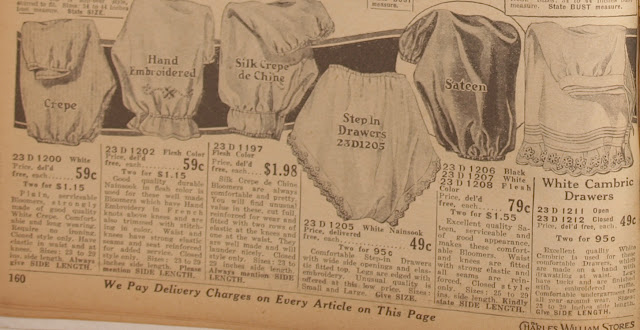I have been doing some research in my free time on the social significance of underwear.
Loin Cloths are the most ancient form of underwear, and archaeological evidence shows some interesting evidence regarding the male side of the underpants equation, however, I'm going to take a looksie at the last 120 years and women's underwear specifically.
First of all, in the late 1800's, early 1900's... only a prostitute would wear closed crotch drawers.
A proper lady would never be caught dead in closed crotch underwear. They felt this would inhibit the flow of beneficial air around the genital area.
"circular drawers" come in both open and closed styles.
"Excellent quality. White Nainsook Circular Drawers. Wide legs edged with white embroidery and top adjusted with tape cut comfortably wide. Sizes 23 to 29 side length.
Give SIDE LENGTH."
Nainsook is a soft fine woven muslin fabric.
These state "Closed Style Only"
Now, the question that has been plaguing me....whats the difference between BLOOMERS, STEP-IN'S, and DRAWERS?
from the left we have: 1 Crepe bloomers, 2 'hand embroidered drawers, 3 silk crepe de chine step in bloomers, 4 step in drawers, 5 sateen bloomers, 6 white cambric drawers.
1 bloomers made of crepe have elastic at the knees and the waistband, only come in closed styles
2 drawers elastic seams at knee and waist. only come in closed styles
3 bloomers elastic at knee and waist and are only closed style
4 step in drawers have no elastic at leg holes but an elastic top
5 bloomers elastic at both knee and waist and closed style only
6 drawers have no closed/open option and the band is a drawstring
 |
from the left: 1 Nainsook Bloomers, 2 White Cambric Drawers 3 Step in Bloomers 4 Nainsook Bloomers 5 Silk Crepe de Chine Step-In Bloomers
Nainsook Bloomers: Elastic at waist and knee/closed only
Cambric Drawers: Drawstring Waist, Open/Closed styles,
Batiste Step in bloomers: Elastic at top
Nainsook bloomers elastic at knee and waist, closed only
Step in bloomers have elastic at top
SO...what the hell is going on?
I actually needed a chart:
NAME
|
ELASTIC Waist?
|
Elastic Knee?
|
Closed/Open?
|
Bloomers
|
waistband
|
knees
|
Closed only
|
Drawers
|
Closed
|
||
Bloomers
|
Waist
|
Knee
|
Closed
|
Step In Drawers
|
Waist
|
-
|
|
Bloomers
|
Waist
|
Knee
|
Closed
|
Drawers
|
-
|
-
|
Closed
|
Bloomers
|
Waist
|
Knee
|
Closed
|
Drawers
|
Open/Closed
|
||
Step-In Bloomers
|
Waist
|
-
|
|
Bloomers
|
Waist
|
Knee
|
Closed
|
Step-In Bloomers
|
Waist
|
Knee
|
Closed
|
BLOOMERS - have elastic at waist and knee, closed crotch design
DRAWERS - Can have elastic seaming, but no elastic. Uses TIES. Can come in both closed and open styles, however as of 1923 closed was more popular.
STEP IN DRAWERS - I believe this is a style, for those who preferred the long drawers without elastic at the knee
Drawers in late 19th century women's undergarments are essentially an undergarment constructed of two leg tubes attached to a waistband. There was no crotch, the only place the legs were joined were the waistband.
More Soon!


